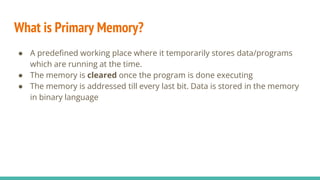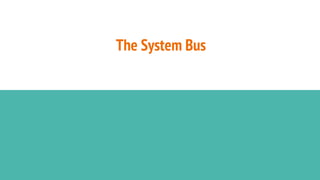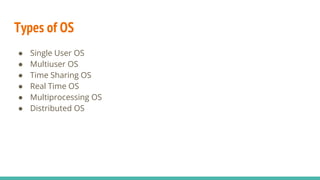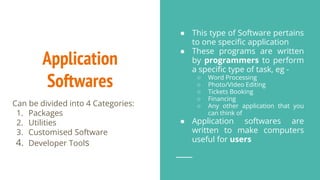Computer System Overview Class XI CS
- 1. Computer System Overview Made By: Tarun Baria, PGT CS, JNV Leh
- 2. What is Computer? A computer is a programmable electronic device that accepts raw data as input and processes it with a set of instructions (a program) to produce the result as output.
- 3. Two Components of Computer: ● Hardware ○ The physical electronic components of a Computer ● Software ○ Recorded instructions and programs to govern the working of the Computer
- 6. Input Unit
- 7. What is Input Unit? ● Formed by Input Devices attached to the Computer ● Takes Input and converts it into computer understandable form (In binary form) ● Computer Input also consist of Data and Instruction
- 9. Output Unit
- 10. What is Output Unit? ● Formed by Output Devices attached to the Computer ● The output that computer generates is in Machine Language (e.g. Binary Language) ● The Output Devices converts the output data into Human Understandable form and presents it to the User
- 12. CPU (Central Processing Unit)
- 13. What is CPU? ● It is the Main Control and Processing Unit of the Computer ● Brain of the Computer ● Components of the CPU: ○ ALU (Arithmetic and Logical Unit) ○ Control Unit ○ Registers
- 14. ALU ● Performs four arithmetic operations (+, -, x, /) ● Performs some logical operations (<, >, <=, >=, !=) ● Decision making takes place in ALU of the CPU Arithmetic and Logical Unit
- 15. CU Control Unit ● Controls and Guides the interpretation, flow and manipulation
- 16. Registers ● Small Units of Data Holding places located near the Processor ● Used to store some important instructions and important data when CPU is running some Program ● Frequently Used instruction/Memory is stored in Registers and rest of the instruction/data is stored in Cache,RAM, etc…
- 17. Memory (Main Memory/Primary Memory)
- 18. What is Primary Memory? ● A predefined working place where it temporarily stores data/programs which are running at the time. ● The memory is cleared once the program is done executing ● The memory is addressed till every last bit. Data is stored in the memory in binary language
- 19. Units of Computer Memory Size Unit Name 1 Bit 1 Bit Bit 4 Bits 1 Nibble Nibble 8 Bits 8 Bits Byte 210 (1024) Byte 1KB Kilo Byte 210 (1024) KB 1MB Mega Byte 210 (1024) MB 1GB Giga Byte 210 (1024) GB 1TB Terra Byte 210 (1024) TB 1PB Peta Byte 210 (1024) PB 1EB Exa Byte 210 (1024) EB 1ZB Zeta Byte
- 20. Parts of Primary Memory ● Random Access Memory (RAM) ● Read Only Memory (ROM)
- 21. Random Access Memory (RAM) ● In RAM, memory cells can be accessed for information transfer from any desired random location. Hence the name, Random Access. ● It is volatile memory (Meaning it gets erased as soon as the power goes off) ● There are two basic types of RAM: ○ Dynamic RAM ○ Static RAM
- 22. DRAM ● Made of Transistors and Capacitors ● Memory Access Time is 20 to 70 nanoseconds ● Used widely in most computers ● Made of flip-flops ● Memory Access Time is about 10 nanoseconds ● Used in specialised applications SRAM
- 23. Read Only Memory (ROM) ● We cannot perform write function on ROM ● In ROM, the data is permanently written during the time of production. It cannot be erased or altered, can only be Read. ● It is non-volatile in Nature ● Slower than RAM
- 24. Types of ROM ● PROM (Programmable ROM) ○ Also called OTP (One TIme Programmable) ○ Information can only be burned in PROM for single time using ROM burner ● EPROM (Erasable Programmable ROM) ○ Can be erased for many times. But Data can only be erased fully. ○ UV - EPROM takes upto 20 minutes to erase the EPROM ● EEPROM (Electrically Erasable Programmable ROM) ○ Data is erased electrically, which is faster ○ Partial data can be erased ● Flash EEPROM ○ Like EEPROM, but faster (takes less than second to erase) ○ Does not erase partially, erases fully ● Mask ROM ○ The contents of the Mask ROM are programmed by IC Manufactured itself and cannot be altered by a programmers
- 25. Storage Unit
- 26. Why do we need Storage Unit? ● Primary Memory has limited storage capacity ● Primary Memory cannot store data permanently ● Hard Disks ● Compact Disks ● DVDs ● Flash Memory ● Blue Ray Disc Different types of Storage
- 27. Hard Disc Drive (HDD) ● Circular Platters situated in the disc spin continually and store data in magnetic form. ● It can have storage capacity varying from several GBs to TBs
- 28. Compact Disks (CDs) ● It is optical media ● Relatively Cheap and offers storage upto 700 Mb Types ● CD - ROM (Read Only Memory) ○ Data is stored at production time and cannot be erased or reused ○ Used for distribution (eg. softwares, games, e-books etc) ● CD - R (Recordable) ○ Can be written on only once. ● CD - RW (Re-Writable) ○ Erasable disc, can be erased and written on multiple times
- 29. Digital Versatile Disks (DVDs) ● It is optical media ● Can hold upto 15 times more storage than CD (15 times more) ● 20 times faster than CD ● Also called Super Density Disk Types ● DVD - ROM (Read Only Memory) ○ Data is stored at production time and cannot be erased or reused ○ Used for distribution (eg. softwares, games, e-books, movies etc) ● CD - R (Recordable) ○ Can be written on only once. ● CD - RW (Re-Writable) ○ Erasable disc, can be erased and written on multiple times
- 30. Blue Ray Disc (BD) ● Optical Media Storage Drive ● Same Dimensions as CD or DVD ● CD and DVD works on Red Lasers which have bigger wavelength ● Blue Ray works on Blue to Violet wavelengths which has smaller wavelengths hence more data can be stored in same space ● Can store upto 128 GB of data
- 31. Flash Memory ● Small, Ultra Portable Storage Device ● Storage is done in ‘solid state’, i.e. it does not use magnetism nor it uses optics (lasers) ● Works similarly as RAM, but it can retain data even when power is switched off ● Inexpensive and more durable compared to HDDs ● Can store data in volume of few GBs to TBs HDD SSD
- 32. The System Bus
- 33. The System Bus An electronic pathway composed of connecting cables and that connects the major components of a computer Data and Instruction are passed among the computer system components through system bus Different System Buses: ● Data Bus: Carries Data ● Control Bus: Carries control instructions ● Address Bus: Carries addresses ● I/O Bus: Connects input, output and other external devices to the system
- 35. Hardware vs. Software ● Hardware represents physical and tangible components of the computer. I.e. those which can be touched ● Software represent the set of programs that govern the operation of a computer system and make the hardware run ○ Softwares can be broadly classified into two types: ■ System Software ■ Application Software
- 36. System Software ● Computer is nothing but a machine that does not know anything by itself. It requires directions/Instructions in order to perform the operations. ● The software which control the internal computer operations is known as System Software Two Types: A. Operating System B. Language Processor
- 37. A. Operating System ● The goal of the OS is to - ○ Make Computer System convenient to use ○ Use computer hardware in efficient manner ● OS is the most important component of the computer which controls all the components of the computer system ● Major components of computer system are: ○ Hardware ○ OS ○ Application Program ○ Users
- 38. How Computer Actually Works ● The hardware provides basic computing resources ● The application software provides the ways to solve the computing/other problems of the user ● Operating System controls and coordinates the use of hardware among the various application programs for the various users ● …Learn by yourself!!! ● More in Chapter 4!
- 39. Types of OS ● Single User OS ● Multiuser OS ● Time Sharing OS ● Real Time OS ● Multiprocessing OS ● Distributed OS
- 40. B. Language Processors ● Language Processor is a special type of Computer Software that can translate the source code into an object code ○ What is Source Code? ■ It refers to a program/code written by a programmer in high level language eg. Python or JAVA or C++ (which is understandable by human/programmer) ○ What is object Code? ■ A code written in machine language or binary code which a machine (computer) can understand ● More in chapter 4!
- 41. Types of Language Processors 1. Assembler: Language Processor that converts assembly language code into machine language code 1. Interpreter: A type of system software that translates and executes instructions written in computer program` line by line/unit by unit 1. Compiler: A system software that translates and executes instructions written in a computer program in a one go ● More in Chapter 4!
- 42. Application Softwares ● This type of Software pertains to one specific application ● These programs are written by programmers to perform a specific type of task, eg - ○ Word Processing ○ Photo/VIdeo Editing ○ Tickets Booking ○ Financing ○ Any other application that you can think of ● Application softwares are written to make computers useful for users Can be divided into 4 Categories: 1. Packages 2. Utilities 3. Customised Software 4. Developer Tools
- 43. 1. Packages ● Some general softwares are designed that may be used by individual users in a manner that it suits their requirements. Such general application softwares are called packages ● eg ○ Word Processing Software ○ Spreadsheets ○ DBMS ○ Graphics Designing Software
- 44. 2. Utilities ● Those helpful programs that ensure the smooth functioning of the Computer ● Utility Programs are meant to assist your computer ○ Text Editor ○ Backup Utility ○ Compression Utility ○ Disk Defragmenter ○ Anti Virus
- 45. 3. Customized Software ● These softwares are specially created to fulfill the business requirement ● eg. ○ Hotel Management and Reservation ○ Finance/Accounting ○ Inventory Management ○ tailor - made softwares
- 46. 4. Developer Tools ● These softwares help programmers when they are writing programs or developing softwares ● Developer tools are set of codes/functions/scripts/classes etc…
- 48. Thank You!



















































































































